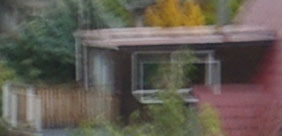Pentax K200D
-
-
Written by Gordon Laing
Pentax K200D lens and stabilisation
The Pentax K200D is equipped with a KAF2 bayonet lens mount which is compatible with KAF2, KAF and KA lenses. Like earlier Pentax DSLRs, the K200D also works with a wide variety of older Pentax optics (albeit with certain restrictions), including K lenses and even M42 and medium format models with the help of optional adapters; as you fit older lenses you’ll increasingly be working in Manual, but it’s still very handy to have the option.
 |
Like the K10D and K20D, the K200D also supports the company’s latest DA* lenses equipped with internal supersonic SDM focusing motors; these lenses also sport environmental sealing to match the K200D.
Like all Pentax DSLRs so far, the K200D’s sensor results in the field of view of all lenses being reduced by 1.5 times, so the optional DA 18-55mm kit lens delivers an effective focal range of 27-83mm. Unfortunately Pentax was unable to supply this lens for our tests, so we used the optional DA 18-250mm super-zoom instead.
As you’ll see in our results and gallery pages, this lens is capable of delivering surprisingly good results considering its super-zoom range and affordable price, with very sharp details right into the corners. The focusing may be relatively slow and noisy, but the optical quality and range for the money makes it an ideal general-purpose lens for the K200D.
A headline feature of the K200D is built-in Shake Reduction to combat camera shake. First seen on the Pentax K100D, this uniquely employs magnets to adjust the position of the sensor. Like other body-based DSLR stabilisation systems the great advantage is being able to enjoy the benefit with any lens you attach, new and old. The disadvantage is not being able to see the stabilising effect through the viewfinder (and unlike Sony, there’s not even indicators showing how hard it’s working). Since there’s no Live View on the K200D, you can’t preview the effect on-screen either.
Unlike rival bodies with built-in sensor-shift stabilisation though, the Pentax Shake Reduction system uniquely supports rotational compensation along with the usual vertical and horizontal axes. Pentax claims this all provides the K200D with up to 4 stops of compensation, and the system can be switched on or off using a control on the rear surface. The Shake Reduction system also makes use of lens focal length data from supporting optics or you can manually enter the details of older lenses from 8 to 800mm.
To test the effectiveness of the K200D’s built-in stabilisation we took a serious of photos with it and the DA 18-250mm zoomed-into an equivalent of 75mm where traditional photographic advice would recommend a shutter speed of 1/75 to eliminate camera shake. Our sequence started at a shutter speed of 1/100 and reduced one stop at a time until 1/3 of a second.
|
Pentax K200D Shake Reduction off / on | ||
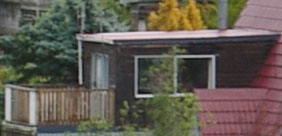 | ||
100% crop, 18-250mm at 50mm, 1/6, 100 ISO, SR off |
100% crop, 18-250mm at 50mm, 1/6, 100 ISO, SR on | |
Without Shake Reduction enabled, the slowest shutter speed with which we could achieve a sharp image (at an equivalent of 75mm) was 1/25, whereas with SR enabled we achieved sharp results down to shutter speeds of 1/6. You can see 100% crops taken from the 1/6 samples above.
A shutter of 1/6 corresponds to two stops of compensation over the 1/25 non-stabilised shot, and 3.5 stops over the 1/75 speed suggested by traditional advice. As always, the lens, conditions and the photographer themselves can produce different results, but here the K200D’s built-in stabilisation isn’t performing quite as well as those from Sony or Olympus which consistently provided three stops in practice. We also measured a similar result with the K20D and K10D.
Pentax K200D focusing
The Pentax K200D is equipped with an 11-point Autofocus system, using the same SAFOX VIII sensor as the K20D; the central nine focusing points are cross-type sensors. Note, the AF sensor array may mirror the K20D, but that camera’s additional processing and battery power may allow it to achieve faster AF in some conditions.
The K200D may also not have the K20D’s physical switch to set the AF area mode, but you can change it from a menu to one of the same three modes: Auto which selects from all 11 points, Select which allows you to manually choose one of the 11 points through the viewfinder using the cross-keys, and Center which sets the focusing area to the centre of the viewfinder. If you’re using older lenses, the focus point is always locked to the centre regardless of the mode selected.
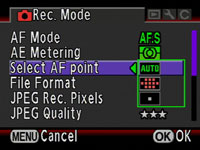 |
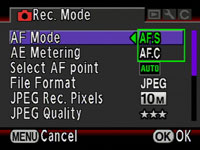 |
Like the K20D, there’s also three different focusing modes, although the external switch to the left side of the lens mount only offers the choice of Manual or Autofocus. To switch between AF.S (single) and AF.C (continuous), you’ll need to enter the menu system.
The K200D does not offer the K20D’s AF adjustment option to fine-tune lenses, but it does have the Catch-focus mode. This allows you to manually focus the lens at a set distance, then only have the K200D trigger the shutter when the subject moves into focus.
The 11-point AF system of the K200D is more sophisticated than the 9-point or 3-point systems used by most of its rivals at the same price-point, but of course it requires a suitable lens to strut its stuff. Pentax was only able to supply our K200D sample with the DA 18-250mm superzoom lens, and while this model delivers sharp details across the frame, it’s neither the world’s fastest or quietest focuser. In practice with this lens, the K200D (like the K20D) would roughly but quickly adjust the focus before slowing down and performing tiny steps to get it spot on. To really see what the K200D is capable of in terms of AF and motion tracking, you’ll really need to equip it with a more responsive lens, like one of the Pentax SDM models. If fast focusing is important to you, consider the DA* 16-50mm SDM.
Pentax K200D metering, exposures and bracketing
The Pentax K200D offers the same three metering modes as the K10D and K20D: Spot, Center-weighted and Multi Segment, the latter employing a 16-segmented system. 16 Segments is considerably fewer than the 420 of the similarly-priced Nikon D60, and in use the K200D, like other Pentax DSLRs we’ve tested, certainly lacks the almost uncanny ability of Nikon’s 3D Matrix Metering to correctly evaluate the scene almost every time.
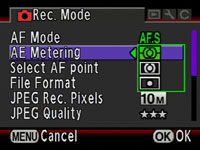 |
So once again, the K200D appears to under-expose most of its shots in Multi Segment mode, particularly those which were dark to start with. More offen than not we had to apply at least one stop of positive exposure compensation. Of course the positive spin on this is that the K200D is unlikely ever to blow any highlights, but this erring on underexposure is becoming a trend with Pentax DSLRs. See our Gallery for more examples.
The K200D offers the same shutter speed range as the K10D and K20D, running from 1/4000 to 30 seconds plus Bulb in half or third-stop increments. Unlike those models though, exposure compensation is only offered in a fixed range of +/-2EV, regardless of whether you’ve selected half or one third EV increments in the custom section.
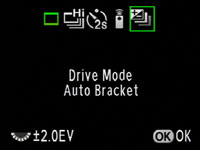 |
The K200D offers exposure bracketing of three frames up to 2EV apart. This is fairly normal for a camera of its price and target market, but illustrates another aspect in which the higher-end K20D is more sophisticated.
The K20D’s exposure bracketing can take three or five frames up to 2EV apart, along with offering a One Touch option which takes them all with a single button press.
The K20D additionally offers bracketing for White Balance, saturation, hue, sharpness and contrast.
Pentax K200D anti dust
The K200D employs its anti-shake system in the battle against dust. By vigorously shaking the sensor, the K200D attempts to shake-free any foreign particles which have settled on the low pass filter. This process can be manually applied from a menu option, or configured to take place every time the camera powers-up.
The Dust Reduction shake itself lasts for about half a second and can be both felt and faintly heard. If you have it enabled at power-up, it clearly slows the startup time, but only by a fraction of a second – and you can always switch it off if desired.
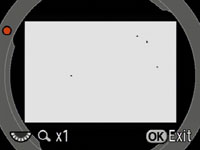 |
Following the K20D is a new Dust Alert option which detects dust on the sensor and creates an image to show you where it is – see screengrab left. This works like an automatic version of taking your own dust reference frame, and the view shown as if you were looking into the open camera body from the front, although having identified the pesky particles, the K200D won’t actually do anything about them. Instead they’re displayed against a white background to show you where to aim your blower.
Following our usual DSLR torture-test we left our K200D face-up without a lens, inside and outside for ten minutes each; we can’t know how much dust entered the body during this time, nor even how much was present to start with, but we know such a process would result in dust being a problem for most models.
We then powered the camera on and off twice to vibrate the filter before taking a series of photos at every aperture setting of a plain white surface at close range with the DA 18-250mm lens zoomed-into 50mm and manually focused to infinity. Dust marks normally become most apparent at the smallest apertures (eg f16 and f22), but it’s also important to test at more common apertures.
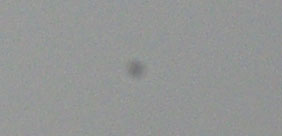 |
Pentax K200D dust example at f22 / f8 | ||
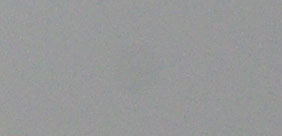 | ||
100% crop, 18-250mm at 50mm, f22 |
100% crop, 18-250mm at 50mm, f8 | |
Following our test the K200D revealed eight dust marks at f22, all easily visible. One typical offender is pictured above left. At f16 these remained quite visible, but were becoming more discreet by f11. At f8, they had become quite diffuse and faint – the same area taken from the f8 sample is pictured above right.
While all dust testing has a random factor, gathering anecdotal evidence is useful, so on the strength of these results we’d say the K200D’s anti-dust system wasn’t particularly effective when we put it through its paces. One consolation was the Dust Alert system did identify the positions of most offending particles, but again you’ll need to employ a blower or a swab to remove them.
Pentax K200D sensor and processing
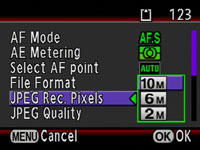 |
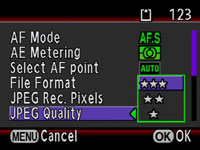 |
The Pentax K200D is equipped with the same 10.2 Megapixel CCD sensor as the K10D. It measures 23.5×15.7mm and generates 3:2 aspect ratio images with a maximum resolution of 3872×2592 pixels – check out our results pages to see how it performs in practice. Note the sensor may be the same as the K10D, but the K200D does not have that camera’s 22-bit A-D conversions. Pentax opted for a more typical 12-bit A-D conversion on the K200D for cost and battery drain considerations.
The K200D gives the choice of three resolutions and three different JPEG compression options; like other Pentax DSLRs the latter are represented by stars with three being the least compressed, best quality option; the additional four star option of the K20D is missing. Alternatively you can record images as a RAW file with or without an accompanying JPEG at any compression or resolution, although the RAW file is always recorded at the maximum resolution. Best quality *** JEPGs typically measure around 4MB each, while DNG RAW files weigh-in at around 16.5MB each.
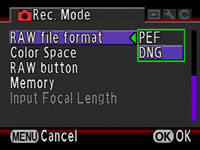 |
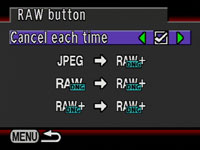 |
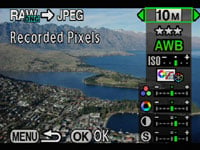 |
Like the K10D and K20D, the K200D refreshingly also allows you to choose whether RAW files are recorded in the proprietary Pentax PEF format or Adobe’s open DNG format – if only all manufacturers were as open-minded. As described on the Design page, the K200D is also impressively equipped with a dedicated RAW button on the side of the body which can be used to switch between JPEG and RAW mode or RAW and RAW plus JPEG mode; you can also configure it so the setting is cancelled or remembered each time you press the button.
Like the K10D and K20D, RAW files can be processed in-camera to create new JPEGs. You can adjust the final resolution, compression level, white balance, sensitivity (-2 to +2), tone, saturation, hue, contrast and sharpness, although sadly unlike the K20D, there’s no option for adjusting the High ISO Noise Reduction here.
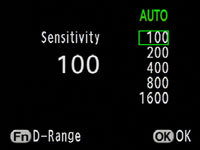 |
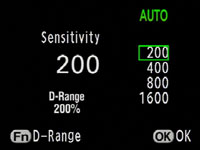 |
The K200D’s sensitivity runs between 100 and 1600 ISO, just like the K10D; the K20D offers sensitivities up to 6400 ISO. The K200D allows you to set a maximum limit to the Auto ISO mode using the thumb dial.
New to the K200D and the K20D is an Expanded Dynamic Range option which is enabled by pressing the Fn button on the sensitivity page. This mode operates between 200 and 1600 ISO, and like Canon’s Highlight Tone Protection, helps prevent blown highlights, although the K200D’s habit of underexposing rarely makes this an issue. Below are examples taken normally, then with Expanded Dynamic Range enabled.
|
Pentax K200D Expanded Dynamic Range off / on | ||
 | ||
Pentax K200D, Expand Off, 200 ISO, 1/6, f3.5, +1EV |
Pentax K200D, Expand On, 200 ISO, 1/6, f3.5, +1EV | |
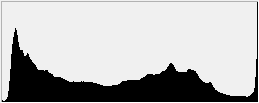 | 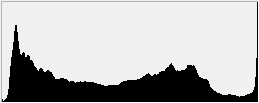 | |
Pentax K200D, Expand Off, Histogram |
Pentax K200D, Expand On, Histogram | |
We shot the normal image, above left, at 200 ISO to match the 200 ISO minimum sensitivity when Expanded Dynamic Range is enabled; the shot taken with Expanded Dynamic Range is above right, and histograms for each image are shown below. The K200D was underexposing this composition regardless of the mode, so we applied +1EV of compensation.
The histograms reveal highlight clipping on both images, but a subtly different tonal curve. Upon close examination, the shot taken with Expanded Dynamic Range shows slightly more detail in the stained glass windows than the normal version, but it’s very subtle. When testing Enhanced Dynamic Range with the K20D, the effect was also fairly subtle. Either way, protection of highlight clipping is slightly redundant on a camera which has a habit of underexposing – it’s the shadows you have to keep an eye on here.
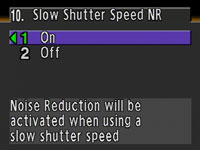 |
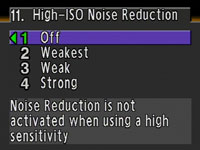 |
The K200D offers two types of noise reduction for slow shutter speeds and High ISO settings; the latter has four settings of off, weakest, weak and strong. Interestingly while most cameras default to a higher degree of NR as standard, the K200D’s default setting, like the K20D, is for High ISO NR to be off. We have examples at all four settings in our results pages.
The White Balance can be set to Auto, Daylight, Shade, Cloudy, three different Fluorescent lights, Tungsten, Flash or Manual. Each can be fine-tuned between green and magenta or blue and amber, while twisting the power dial clockwise will deliver a digital preview.
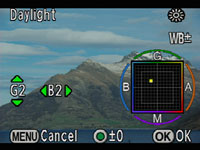 |
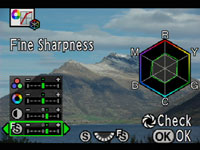 |
New to the K200D is the way you apply tone and sharpening adjustments. After pressing the Fn button, you press OK to enter the Custom Image section. This lets you choose from six main modes: Bright, Natural, Portrait, Landscape, Vibrant and Monochrome.
Bright is the default setting and is therefore what we used for our sample images – and as you’ll see in our Gallery and Results sections, it produces consumer-friendly, punchy images. If the scene was already bright and colourful though, the K200D’s default processing can deliver a slightly unreal result as you’ll see, but it gives you plenty of options for toning it down if preferred.
For each of the colour modes, you can adjust the Saturation, Hue, Contrast and Sharpness by plus or minus four steps; in Monochrome, Hue and Saturation are switched for Filter Effect and Toning. Particularly impressive is the sharpening adjustment which actually offers the choice of fine or coarse steps. And as you make your adjustments, their impact is represented on a colour graph on the right. Like White Balance adjustments, you can again twist the power dial to deliver a preview.
In terms of these tone and sharpening adjustments, the K200D is identical to the higher-end K20D. We were already impressed by this degree of control on the K20D, so to also find it here on an entry-level model is excellent.
Pentax K200D drive modes
The Pentax K200D has two continuous shooting options. Continuous Hi takes pictures at 2.8fps for up to four *** JPEGs. Continuous Lo reduces the speed to a mere 1.1fps, but can continue shooting until the card is full. It’s worth noting the earlier K10D could shoot at 3fps until it ran out of memory.
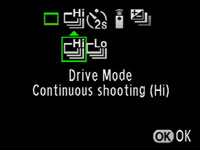 |
To put this to the test we fitted the K200D with a SanDisk Ultra II 1GB card, set the JPEG quality to ***, the shutter to 1/500 and the focus to manual. In Continuous Hi mode, the camera fired-off five frames in 1.8 seconds before greatly slowing down. This corresponds to a fraction under 2.8fps as promised. Switching to RAW DNG mode and the K200D shot the same five frames in 1.8 seconds, again corresponding to almost 2.8fps, although this time there was a pause before you could take another shot.
When most entry-level DSLRs shoot at 3fps, and some at the same price boast 3.5fps, the K200D’s 2.8fps is disappointing, especially as you can only fire-off four or five frames at a time.
The K200D offers a 12 second or two second self timer, the latter with mirror-lockup. There are also two modes for use with an optional remote control: instant and delayed release. A viewfinder cup is provided to prevent stray light from entering the viewfinder, but you will need to remove the rubber surround first.
